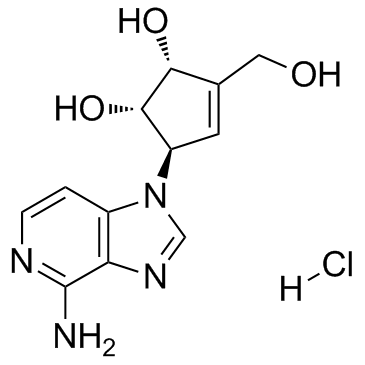3-Deazaneplanocin A (hydrochloride)
Modify Date: 2025-08-25 11:34:52

3-Deazaneplanocin A (hydrochloride) structure
|
Common Name | 3-Deazaneplanocin A (hydrochloride) | ||
|---|---|---|---|---|
| CAS Number | 120964-45-6 | Molecular Weight | 298.725 | |
| Density | N/A | Boiling Point | N/A | |
| Molecular Formula | C12H15ClN4O3 | Melting Point | 168-169℃ | |
| MSDS | Chinese USA | Flash Point | N/A | |
| Symbol |

GHS07 |
Signal Word | Warning | |
Use of 3-Deazaneplanocin A (hydrochloride)3-Deazaneplanocin A hydrochloride is a potent histone methyltransferase EZH2 inhibitor. |
| Name | (1S,2R,5R)-5-(4-aminoimidazo[4,5-c]pyridin-1-yl)-3-(hydroxymethyl)cyclopent-3-ene-1,2-diol,hydrochloride |
|---|---|
| Synonym | More Synonyms |
| Description | 3-Deazaneplanocin A hydrochloride is a potent histone methyltransferase EZH2 inhibitor. |
|---|---|
| Related Catalog | |
| Target |
EZH2[1] |
| In Vitro | 3-Deazaneplanocin A (DZNep) hydrochloride is a potent histone methyltransferase EZH2 inhibitor. Treatment of OCI-AML3 cells with 3-Deazaneplanocin A (1.0 μM) results in a significant increase in accumulation of cells in the G0/G1 phase (58.5%) with a concomitant decrease in the number of cells in S phase (35.2%) and G2/M phases (6.3%) of the cell cycle (P<0.05). Treatment with 3-Deazaneplanocin A (200 nM to 2.0 μM) for 48 hours, dose dependently, inhibits colony growth of OCI-AML3 and HL-60 cells[1]. 3-Deazaneplanocin A (DZNep) hydrochloride reduces the expression of EZH2, especially after 72 hours (e.g. 48%, 32% and 36% reduction of EZH2 in PANC-1, MIA-PaCa-2 and LPc006 cells, respectively)[2]. 3-Deazaneplanocin A (DZNep) hydrochloride shows minimal growth inhibition in PANC-1 cells. More than 50% of these cells are still growing after exposure at the highest concentration (20 μM). MIA-PaCa-2 and LPc006 cells are much more sensitive, with IC0 values of 1.0±0.3 and 0.10±0.03 μM, respectively[2]. 3-Deazaneplanocin A (DZNep) hydrochloride causes dose-dependent inhibition of cell proliferation of NSCLC cell lines, and the IC0 values range from 0.08 to 0.24 μM[3]. |
| In Vivo | The survival of NOD/SCID mice with acute myeloid leukemia (AML) due to HL-60 cells is significantly higher, if treated with 3-Deazaneplanocin A (DZNep) and Panobinostat (PS) compare to treatment with PS, 3-Deazaneplanocin A, or vehicle alone (P<0.05). Median survival is as follows: control, 36 days; PS, 42 days; 3-Deazaneplanocin A, 43 days; and 3-Deazaneplanocin A plus PS, 52 days[1]. There is a progressive increase in weight of rats treated with physiological saline in a time-dependent manner (the mean growth rate=3.19% per day). Administration of 20 mg/kg 3-Deazaneplanocin A (DZNep) not only markedly reduces the relative weight of the rats compare to the initial weight (−2.0%, −4.9% and −1.2%) in the first three days post-treatment, but also suppresses the weight growth rate to 2.6% per day from the fourth day onwards post-dose[4]. |
| Cell Assay | AML HL-60 cells are obtained and maintained. OCI-AML-3 cells are cultured in α minimum essential medium with 10% fetal bovine serum, 1% penicillin/streptomycin, and 1% nonessential amino acids. To analyze synergism between 3-Deazaneplanocin A and PS in inducing apoptosis, cells are treated with 3-Deazaneplanocin A (100-750 nM) and PS (5-20 nM) at a constant ratio for 48 hours. The percentage of apoptotic cells is determined by flow cytometry. The combination index (CI) for each drug combination is obtained by median dose effect of Chou and Talalay, using the CI equation within the commercially available software Calcusyn[1]. |
| Animal Admin | Mice[1] HL-60 cells (5 million) are injected into the tail vein of female nonobese diabetic/severe combined immunodeficiency (NOD/SCID) mice, and the mice are monitored for 7 days. The following treatments are administered in cohorts of 7 mice for each treatment: vehicle alone, 1 mg/kg 3-Deazaneplanocin A, 10 mg/kg PS, and 3-Deazaneplanocin A plus PS. Treatments are initiated on day 7. 3-Deazaneplanocin A is administered twice per week (Tuesday-Thursday) intraperitoneally for 2 weeks, and then discontinued. PS is administered 3 days per week (Monday, Wednesday, and Friday) for 4 weeks. The survival of mice from the tail vein model is represented with a Kaplan-Meier survival plot. Rats[4] Male wistar rats are used. The acute toxicity study is carried out to determine the NOAEL of 3-Deazaneplanocin A in rats. In total, 20 rats are divided into 4 groups of five each. Three groups are intravenously administered 20, 15, 10 mg/kg body weight (BW) DZNep solution by the tail vein. The remaining group is given physiological saline (0.9% NaCl saline) as the control group. Then, the NOAEL of free DZNep is determined, depending on the following endpoint parameters obtained. |
| References |
| Melting Point | 168-169℃ |
|---|---|
| Molecular Formula | C12H15ClN4O3 |
| Molecular Weight | 298.725 |
| Exact Mass | 298.083282 |
| PSA | 117.42000 |
| LogP | 0.59190 |
| Appearance of Characters | white to beige |
| Storage condition | ?20°C |
| Water Solubility | H2O: ≥5mg/mL |
|
Jak3, STAT3, and STAT5 inhibit expression of miR-22, a novel tumor suppressor microRNA, in cutaneous T-Cell lymphoma.
Oncotarget 6 , 20555-69, (2015) Aberrant activation of Janus kinase-3 (Jak3) and its key down-stream effectors, Signal Transducer and Activator of Transcription-3 (STAT3) and STAT5, is a key feature of malignant transformation in cu... |
| 3-Deazaneplanocin A (DZNep) hydrochloride |
| 3-Deazaneplanocin A hydrochloride |
| 3-deazaneplanocin A (DZNeP) HCl |
| CS-0870 |
| 3-Deazaneplanocin A (hydrochloride) |